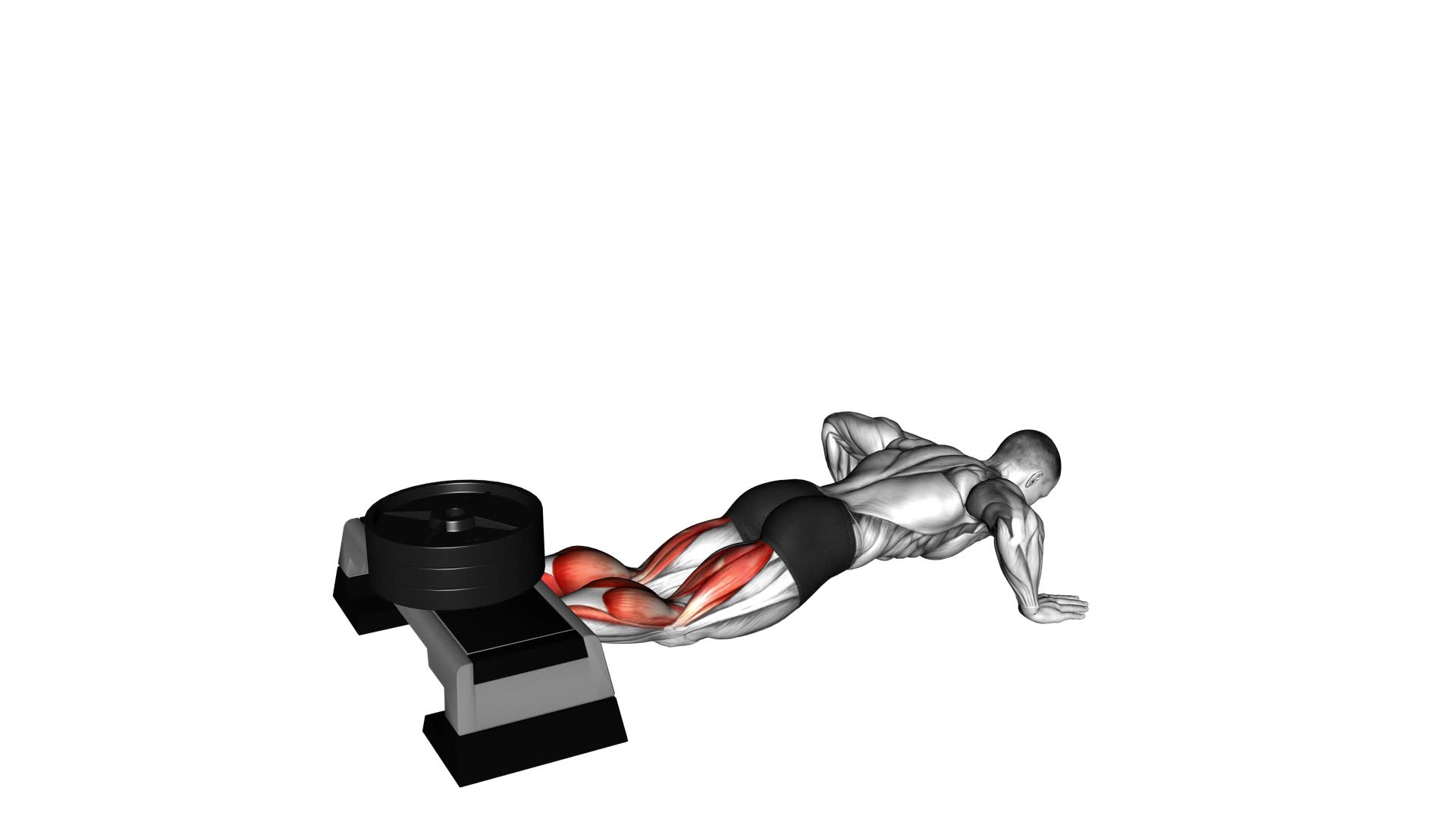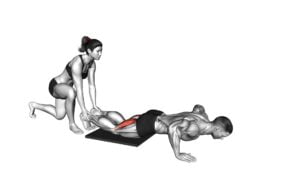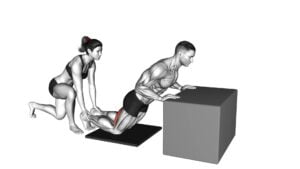Self Assisted Inverse Leg Curl (VERSION 2) – Video Exercise Guide & Tips

Get ready to take your leg workouts to the next level with the self-assisted inverse leg curl (version 2). In this video exercise guide, we'll show you the proper technique and form to maximize your results.
Watch This Exercise Video
With just a few pieces of equipment, you can easily perform this effective exercise at home or at the gym. Follow our tips to ensure safety and get the most out of your leg curl routine.
Let's get started!
Key Takeaways
- The self-assisted inverse leg curl targets the hamstrings, glutes, and lower back muscles while strengthening and toning these areas.
- Proper technique and form are important to engage the core, control the descent, avoid using momentum, and maintain a neutral spine.
- Variations and modifications include using a resistance band for assistance, performing the exercise with a single leg, and experimenting with different foot positions.
- Safety precautions include avoiding excessive momentum, listening to your body for any pain or discomfort, and gradually increasing intensity and weight to avoid strain or injury.
Benefits of the Self Assisted Inverse Leg Curl
You can experience several benefits by incorporating the self-assisted inverse leg curl into your workout routine. This exercise specifically targets your hamstrings, glutes, and lower back muscles, making it an effective way to strengthen and tone these areas. The main muscle worked during the self-assisted inverse leg curl is the hamstring group, which consists of the biceps femoris, semitendinosus, and semimembranosus. By regularly performing this exercise, you can increase the strength and flexibility of your hamstrings, improving your overall lower body stability and preventing injuries.
Furthermore, the self-assisted inverse leg curl allows for progression and variations to challenge yourself as you become stronger. As you gain more strength and control, you can gradually increase the weight or resistance used during the exercise. This can be done by using ankle weights, resistance bands, or even a machine specifically designed for the inverse leg curl. Additionally, you can experiment with different foot positions to target different areas of your hamstrings and glutes.
Incorporating the self-assisted inverse leg curl into your workout routine can bring numerous benefits, such as improved hamstring strength, enhanced lower body stability, and increased flexibility. With its progression and variation options, this exercise can be tailored to your fitness level and goals, making it a valuable addition to any leg day routine.
Proper Technique and Form for the Exercise
To perform the self-assisted inverse leg curl with proper technique and form, focus on maintaining a controlled movement throughout the exercise. Here are some important tips to keep in mind:
- Keep your upper body stable: Make sure to engage your core and keep your upper body still throughout the movement. This will help isolate the muscles in your legs and prevent any unnecessary strain on your back.
- Control the descent: As you lower your legs, avoid letting them drop quickly. Instead, focus on slowly and smoothly lowering them back down to the starting position. This will engage your muscles throughout the entire range of motion.
- Avoid using momentum: It's important to rely on the strength of your leg muscles rather than using momentum to complete the exercise. This will ensure that you're targeting the correct muscles and getting the most out of the exercise.
Common mistakes to avoid include:
- Arching your back: This can lead to strain on your lower back. Make sure to maintain a neutral spine throughout the exercise.
- Using excessive weight: Start with a weight that allows you to maintain proper form and gradually increase the resistance as you become stronger.
Variations and modifications:
- If you find the exercise too challenging, you can start by using a resistance band for assistance. This will help you build strength gradually.
- For a greater challenge, you can try performing the exercise with a single leg instead of both legs at the same time. This will increase the demand on your muscles and improve stability.
Equipment Needed for the Self Assisted Inverse Leg Curl
To perform the self-assisted inverse leg curl, you'll need a piece of equipment called a leg curl machine. This machine consists of a padded bench with a lever and weight stack attached to it. The lever is positioned at the end of the bench, allowing you to secure your feet under it. The weight stack provides resistance for your leg muscles during the exercise.
The leg curl machine is specifically designed to target the muscles in the back of your thighs, namely the hamstrings. It allows you to perform the self-assisted inverse leg curl with proper form and control. However, if you don't have access to a leg curl machine, there are alternative exercises that you can try. These include bodyweight exercises like glute bridges, hamstring curls with resistance bands, or stability ball hamstring curls.
For beginners or those who may not have the strength or flexibility to perform the self-assisted inverse leg curl, there are modifications that can be made. One modification is to start with a lower weight on the leg curl machine, gradually increasing the weight as your strength improves. Another modification is to use a resistance band or towel to assist with the movement until you're able to perform the exercise without assistance.
Remember to consult with a fitness professional to ensure proper technique and form when performing the self-assisted inverse leg curl or any alternative exercises.
Tips to Maximize Results During the Exercise
To maximize your results during the exercise, it's important to focus on maintaining proper form and engaging your muscles with each repetition. Here are some tips to help you get the most out of your self-assisted inverse leg curl:
- Common Mistakes:
- Avoid using momentum to swing your legs up. This reduces the effectiveness of the exercise and increases the risk of injury.
- Don't forget to breathe. It's easy to hold your breath during challenging exercises, but proper breathing helps oxygenate your muscles and improve performance.
- Avoid arching your back or rounding your shoulders. Keep your spine neutral and engage your core for stability.
Variations and Modifications:
- If you find the exercise too challenging, you can use a resistance band or a lighter weight to assist you.
- To make the exercise more challenging, you can add ankle weights or increase the weight on the machine.
- If you don't have access to a machine, you can perform a modified version of the exercise using a stability ball or a bench.
Safety Precautions to Consider While Performing the Self Assisted Inverse Leg Curl
When performing the self-assisted inverse leg curl, it's important to take certain safety precautions to avoid injury and ensure proper execution.
One common mistake to avoid is using too much momentum or swinging the body to complete the movement. This not only reduces the effectiveness of the exercise but also increases the risk of strain or injury to the muscles and joints. To prevent this, focus on maintaining control throughout the entire range of motion.
Another important safety precaution is to ensure proper form and alignment. Keep your core engaged and your back straight throughout the exercise. Avoid arching your back or rounding your shoulders, as this can put unnecessary stress on your spine.
It's also important to start with a weight that you can handle comfortably and gradually increase the resistance as you become stronger and more confident in your technique.
Modifications and progressions can be made to suit your fitness level and goals. If you're a beginner, you can start by performing the exercise with both feet on the floor and gradually progress to lifting one foot off the floor. As you become more advanced, you can add resistance by using ankle weights or a resistance band.
Remember to always listen to your body and adjust the exercise as needed to prevent any discomfort or pain.
Frequently Asked Questions
How Many Sets and Repetitions Should I Do for the Self Assisted Inverse Leg Curl?
For the self-assisted inverse leg curl, the number of sets and repetitions can vary depending on your fitness level and goals. It's recommended to start with 2-3 sets of 8-12 repetitions.
This exercise targets your hamstrings and glutes, helping to increase strength and stability in your lower body.
To progress and increase difficulty, you can add ankle weights or resistance bands, or even try single-leg variations.
Always focus on maintaining proper form and listen to your body to avoid injury.
Can I Perform the Self Assisted Inverse Leg Curl if I Have a Knee Injury?
Yes, you can still perform the self-assisted inverse leg curl even if you have a knee injury. However, it's important to consult with a healthcare professional before attempting any exercise.
If you have a knee injury, there are alternative exercises and modifications available that can help you work your legs without putting excessive strain on your knees. These alternatives and modifications are especially beneficial for beginners who are just starting their fitness journey.
Is It Necessary to Use a Specific Type of Equipment for the Self Assisted Inverse Leg Curl?
To perform the self assisted inverse leg curl, you don't necessarily need a specific type of equipment. There are different variations of this exercise that can be done using a stability ball or a TRX suspension trainer.
Incorporating the self assisted inverse leg curl into your workout routine offers several benefits. It targets your hamstrings and glutes, helps improve lower body strength, and enhances stability and balance.
Can I Do the Self Assisted Inverse Leg Curl at Home Without Any Equipment?
Yes, you can definitely do the self-assisted inverse leg curl at home without any equipment. It's a great exercise for home workouts as it targets your hamstrings, glutes, and lower back.
To modify the exercise for beginners or those with limited space/equipment, you can use a stability ball or a towel to support your legs instead of a machine. This allows you to still engage the same muscles while adapting to your specific needs.
Are There Any Alternative Exercises That Target the Same Muscles as the Self Assisted Inverse Leg Curl?
Looking for alternative exercises that target the same muscles as the self-assisted inverse leg curl? Incorporating these exercises into your routine can provide great benefits.
Try the glute bridge, hamstring curls, or Romanian deadlifts. These exercises engage your glutes, hamstrings, and lower back, just like the self-assisted inverse leg curl.
Conclusion
In conclusion, the self-assisted inverse leg curl is a beneficial exercise for strengthening and toning the hamstring muscles. By following proper technique and using the necessary equipment, individuals can maximize their results and minimize the risk of injury.
It's important to consider safety precautions while performing this exercise to ensure a safe and effective workout. Incorporating the self-assisted inverse leg curl into your fitness routine can help improve lower body strength and enhance overall athletic performance.

Author
Years ago, the spark of my life’s passion ignited in my mind the moment I stepped into the local gym for the first time. The inaugural bead of perspiration, the initial endeavor, the very first surge of endorphins, and a sense of pride that washed over me post-workout marked the beginning of my deep-seated interest in strength sports, fitness, and sports nutrition. This very curiosity blossomed rapidly into a profound fascination, propelling me to earn a Master’s degree in Physical Education from the Academy of Physical Education in Krakow, followed by a Sports Manager diploma from the Jagiellonian University. My journey of growth led me to gain more specialized qualifications, such as being a certified personal trainer with a focus on sports dietetics, a lifeguard, and an instructor for wellness and corrective gymnastics. Theoretical knowledge paired seamlessly with practical experience, reinforcing my belief that the transformation of individuals under my guidance was also a reflection of my personal growth. This belief holds true even today. Each day, I strive to push the boundaries and explore new realms. These realms gently elevate me to greater heights. The unique combination of passion for my field and the continuous quest for growth fuels my drive to break new ground.







